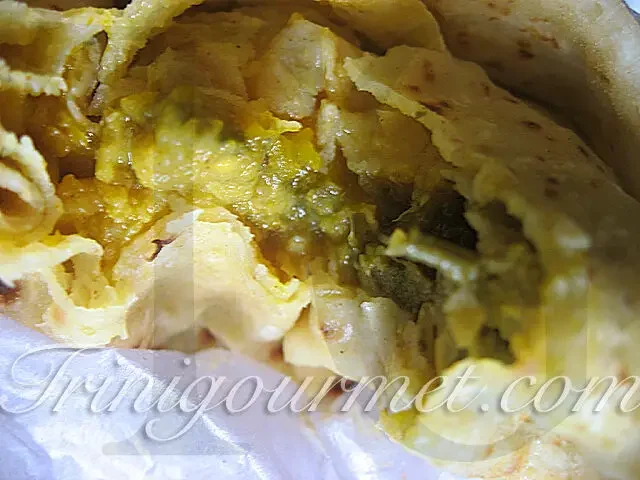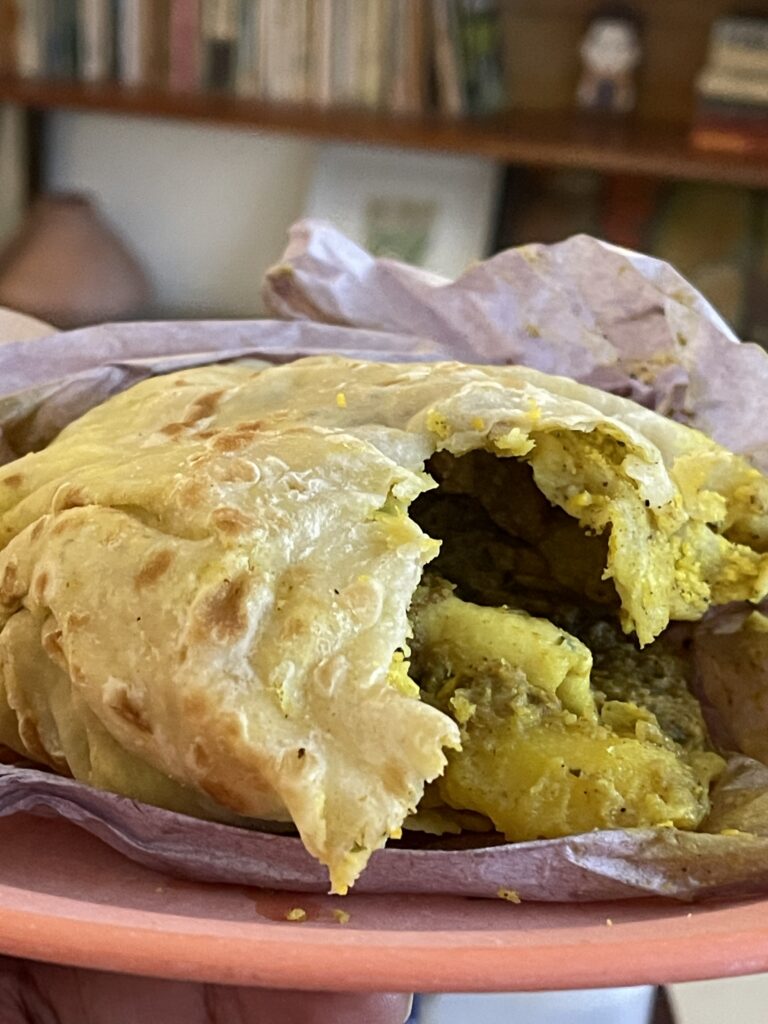All About Trinidadian Roti: Types & Traditions

Roti. Four little letters that have the power to put any Trini into a smile-infused stupor 🙂 Along with pelau I consider it one of Trinidad’s national dishes. East Indian in origin Trinidad roti has now become its own entity with several variants offered to the sidewalk or fast food consumer.
You see, roti here isn’t just a food group. It’s a whole love language. A comforting gesture. A cultural inheritance. And the sheer variety we consume regularly only serves to prove how much we adore it. There’s the humble sada roti, perfect for scooping up hot tomato choka. The delicate, powdery layers of dhalpuri, spilling yellow split peas with every bite. The soft, buttery folds of paratha, also called buss-up-shut, ripped and dipped into thick curry sauce. And the new darling on the block: pepper roti—spicy, often cheesy, and heartily sandwiched for those who like their comfort with a little kick.
Whether you’re grabbing a wrapped roti from a roadside vendor or tearing pieces of a freshly made skin at your grandmother’s table, this dish is more than sustenance. It’s memory, tradition, and a symbol of home.
So today, we’re taking a journey through the rich and evolving world of Trinidadian roti—from its historic roots to its modern-day reinventions. No recipes, just culture, cravings, and a whole lotta love.
1. Roti’s Journey: From India to the Islands
Roti first made its way to Trinidad in the 1840s with the arrival of East Indian indentured labourers. Along with their customs, they brought food traditions that would eventually become staples of Trinidadian cuisine. What was once a symbol of survival became an emblem of comfort and celebration.
Trinidadian roti, cooked on a flat iron tawa, evolved in style and technique. Over generations, we created different fillings, layered flavours—and with each change, made the roti more “we own”.
2. Sada Roti: The Humble Hero
Sada roti is the minimalist of the bunch, but don’t let its simplicity fool you. Often served hot off the tawa alongside tomato choka, fry aloo, or baigan choka, sada is our go-to breakfast bread. In many homes, the smell of a puffing sada roti signals that love is being served soon.
It’s also the most likely to be made at home, thanks to its ease and versatility.

3. Dhalpuri Roti: Layers of Legacy
The roti of weddings, big limes, and long lines outside the roti shop on a Friday afternoon.
The dough is filled with seasoned ground split peas, toasted geera (cumin), and garlic, then rolled out so thin that the filling becomes one with the dough. When cooked just right, dhalpuri leaves a trail of fine yellow flakes on your plate—and your shirt if you’re not careful!
It’s the classic roti skin used to wrap everything from curried goat to stewed pumpkin and bhaji. This is Trinidadian comfort food at its finest.
4. Paratha (Buss-Up-Shut): The Flaky Favourite
Paratha—better known by its nickname buss-up-shut—is beloved for its soft, flaky, buttery layers. It gets its name because once it’s cooked, it’s beaten with wooden spatulas until it looks like a “burst-up shirt.”
This roti is often reserved for Sunday lunch or special occasions. You don’t wrap anything with this one—instead, you tear and scoop, getting just the right amount of sauce with each piece.
5. Dosti Roti: The Symbol of Friendship
The word dosti means friendship in Hindi, and dosti roti is a beautiful metaphor for it. Two thin layers of dough are rolled and cooked together with a bit of oil in between.
Though not as common as sada or dhalpuri, dosti roti is still cherished, especially among families preserving traditional recipes. It’s tender, comforting, and perfect with light veggie dishes or lentil-based curries.

6. Pepper Roti: The Spicy Star on the Rise
Pepper roti is one of the newest stars in the Trinidadian roti universe—and it’s a fiery crowd-pleaser.
Made by sandwiching a spiced filling of mashed potatoes, hot peppers, carrots, and yes, grated cheese between two layers of paratha dough, it’s then roasted on the tawa until golden and blistered.
Though it’s a more recent addition, pepper roti has quickly become a favourite. Its invention, rumoured to have come from reusing wedding food leftovers, is a testament to Trini ingenuity.
Roti: A Taste of Home, A Story of Us
Here’s something you’ll only understand if you’ve grown up in T&T: when someone says they’re going to “buy a roti,” they don’t mean just the flatbread. They mean a dhalpuri roti wrapped and stuffed burrito-style around a curried filling usually chicken, beef, goat, pumpkin, bhaji, mango (or some combination thereof).
Everyone has their preferred roti shop—Hot Shoppe, Patraj, The Roti Café, Don’s, Ali’s, the names are endless and run the gamut of the islands (particularly Trinidad). Everyone has strong opinions about who makes the fluffiest dhalpuri or the softest buss-up-shut. It’s part of the experience, the culture, and the camaraderie.
Essential Picks for Your Roti-Making Adventures:
- Cast Iron Tawa – A must-have for making authentic roti at home.
- Stainless Steel Rolling Pin Set – For evenly rolled, paper-thin roti skins.
- Spice Grinder – Perfect for making your own geera and masala.
- Silicone Pastry Brush – Ideal for oiling your paratha roti just right.
Conclusion:
From its roots in East Indian tradition to its present-day place as a cornerstone of our cuisine, roti in Trinidad has become a symbol of who we are. Each variety—sada, dhalpuri, paratha, dosti, and pepper roti—carries with it generations of flavour, memory, and meaning.
It’s in the act of kneading dough, passing down techniques, arguing over the best roti shop, and wrapping love in curry and spice. Roti is more than food—it’s our history, our heritage, and our home.
Hungry for more Trini nostalgia?
Download my free ebook “7 Sweet Trini Treats”—a heartfelt collection of beloved island favourites, lovingly curated to bring a little sweetness to your kitchen and soul.
Whether you grew up with these flavours or you’re just discovering them, this ebook is my gift to you—a celebration of culture, comfort, and Caribbean joy.





